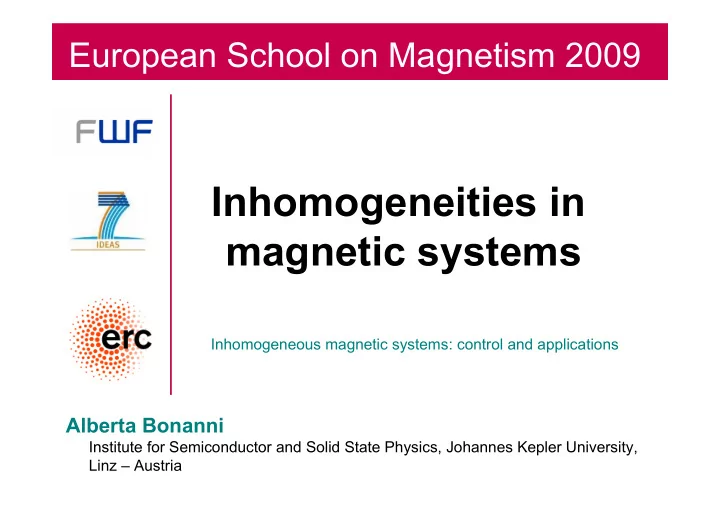

European School on Magnetism 2009 Inhomogeneities in magnetic systems Inhomogeneous magnetic systems: control and applications Alberta Bonanni Institute for Semiconductor and Solid State Physics, Johannes Kepler University, Linz – Austria
Control over magnetic ions aggregation Strain e.g. vertical alignement of InAs QDs in GaAs PbSe/Pb 1-x Eu x Te superlattices G.Springholz et al. Science 282 , 734 [1998] Review : J.Stangl, V.Holý, G.Bauer, Rev.Mod.Phys. 76 , 689 [2004]
Ways to control the aggregation of TM 1] growth rate 2] growth temperature 3] co-doping with donors or acceptors T. Dietl, Nature Mat. 5 , 673 [2006] L.H. Ye and A. Freeman, Phys.Rev. B 73 , 81304 [2006]
Why aggregation of magnatic ions? Unique aspect of our material systems: ▪ d -levels in the gap ▪ contribute to the bonding ▪ foster attractive force between magnetic ions ▪ kinetic barrier to the formation of ferromagnetic nanocrystals By changing the valency ▪ modification of the attractive force ▪ influence on the magnetic ions aggregation
3] co-doping with donors or acceptors A. Bonanni et al. Phys.Rev.Lett. 101 , 135502 [2008]
Control by co-doping ▪ TM-related states reside in the host band gap ▪ charge state and intersite Coulomb repulsion can be changed by co-doping with shallow impurities ▪ the Coulomb repulsion between TM ions hinders spinodal decomposition GaN GaN:Si GaN:Mg E F Fe +3 T. Dietl, Nature Mat. 5 , 673 [2006]
Control by co-doping ▪ TM-related states reside in the host band gap ▪ charge state and intersite Coulomb repulsion can be changed by co-doping with shallow impurities ▪ the Coulomb repulsion between TM ions hinders spinodal decomposition GaN GaN:Si GaN:Mg E F E F Fe +3 Fe +2 T. Dietl, Nature Mat. 5 , 673 [2006]
Control by co-doping ▪ TM-related states reside in the host band gap ▪ charge state and intersite Coulomb repulsion can be changed by co-doping with shallow impurities ▪ the Coulomb repulsion between TM ions hinders spinodal decomposition GaN GaN:Si GaN:Mg E F E F Fe *4 = Fe +3 + h Fe +3 Fe +2 E F T. Dietl, Nature Mat. 5 , 673 [2006]
(Zn,Cr)Te – effect of codoping on Cr distribution o C] 240220200 180 160 140 120 T CdI2 [ 300 Critical Temp. [K] Θ P N-doped Critical Temp. [K] 300 200 200 T C 100 100 T B T C Θ P 0 0 20 21 10 10 -3 ] -3 ] [N] [cm 19 18 17 [ I ] [ cm 10 10 10 Optimized N-doped 50nm Inhomogeneous Homogeneous S. Kuroda et al ., Nature Mater. 6 , 440 [2007]
Effect of Si-doping Quenching of ferromagnetic response
Effect of Si-doping [on secondary phases] Quenching of ferromagnetic response * * Reduction/dissolution of secondary phases
Effect of Si-doping [on chemical decomposition] Quenching of ferromagnetic response Reduction/dissolution of chemical decomposition
(Ga,Fe)N:Si – synchrotron XANES Si doping – effect on Fe charge state M. Rovezzi, ..AB, ...Phys.Rev. B 79 , 195209 [2009]
(Ga,Fe)N:Si – synchrotron XANES Si doping – effect on Fe charge state Fe 3+ M. Rovezzi, ..AB, ...Phys.Rev. B 79 , 195209 [2009]
(Ga,Fe)N:Si – synchrotron XANES Si doping – effect on Fe charge state Fe 3+ M. Rovezzi, ..AB, ...Phys.Rev. B 79 , 195209 [2009]
(Ga,Fe)N:Si – synchrotron XANES Si doping – effect on Fe charge state Fe 3+ Fe 3+ M. Rovezzi, ..AB, ...Phys.Rev. B 79 , 195209 [2009]
(Ga,Fe)N:Si – synchrotron XANES Si doping – effect on Fe charge state Fe 3+ Fe 2+ Fe 3+ M. Rovezzi, ..AB, ...Phys.Rev. B 79 , 195209 [2009]
Co-doping and TM aggregation summary A. Bonanni et al. Phys.Rev.Lett. 101 , 135502 [2008]
Outlook
Outlook: self-organized nanocolumns Ge 1-x Mn x M. Jamet et al., Nature Mat. 5 , 653 [2006]
Outlook: self-organized nanocolumns Ge 1-x Mn x (Al,Cr)N L. Gu et al., JMMM 290 , 1395 [2005] M. Jamet et al., Nature Mat. 5 , 653 [2006]
Self-organized nanomagnets in semiconductors Domain walls for 3D memories electric current induces the shift of magnetic regions along a wire HD does not need to spin increased data storage and speed G. Meier et al., Phys.Rev.Lett. 98 , 187202 [2007] Unclear: how to fabricate dense arrays of required nanocolumns self-organized nanocolumns in DMS [?]
Spin-battery – GaAs:MnAs P. Nam-Hai et al., Nature 458 , 489 [2009]
Functionalities ▪ nanometallization: nanoelectronics, optoelectronics, plasmonics ▪ large magnetotransport effects field sensors ▪ large magnetooptical effects optical isolators, tunable photonic crystals ▪ spintronic structures high density MRAMs/race track memories/logic ▪ spin battery P. Nam-Hai et al., Nature 458 , 489 [2009] H. Katayama-Yoshida et al., ▪ large spin entropy Jpn.J.Appl.Phys 46 , L777 [2007] thermoelectricity
In collaboration with A. Navarro-Quezada, B. Faina, T. Li, M. Wegscheider, D. Leite, A. Grois and T. Devillers Institute for Semiconductor Physics, Johannes Kepler University, Linz – Austria R.E. Lechner, and G. Bauer Institute for Semiconductor Physics, Johannes Kepler University, Linz – Austria Z. Mat ě j, and V. Holý Dept. of Cond. Matter Physics, Charles University, Prague – Czech Republic M. Rovezzi, and F. D‘Acapito INFM, GILDA ESRF beamline, Grenoble – France W. Stefanowicz, M. Kiecana, R. Jakie ł a, M. Sawicki, and T. Dietl Institute of Physics, Polish Academy of Sciences, Warsaw – Poland
Recommend
More recommend